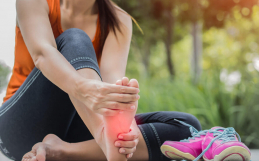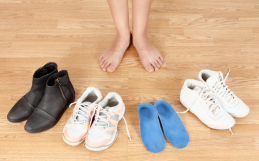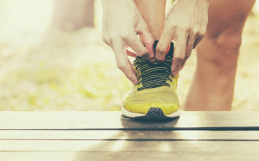As adults, we can generally tell if a shoe feels comfortable or not but children often have trouble expressing this. If you ask them how a shoe feels they will generally, to the dismay of the parent say, “I don’t know”? Or worse yet, your child is too young to tell you anything at all.
There are a number of shoe fitting and shoe sizing criteria that we should all follow and they are especially important for children. When buying any children’s shoe we need to consider the shoes construction and materials, the type of outsole, the type of closure, the function of the shoe for certain activities, the supportive elements of the shoe and most importantly, the fit.
Tips for Finding Proper Fitting Shoes for Your Child
During back-to-school season and throughout the year, one of the most important purchases on any parent’s shopping list should be a pair of proper fitting shoes for their child. For many parents, shoe shopping may seem easier than a pop-quiz in gym class, but several important factors should be considered:
- Children’s Feet Change With Age. Shoe and sock sizes may change every few months as a child’s feet grow.
- Shoes That Don’t Fit Properly Can Aggravate the Feet. Always measure a child’s feet before buying shoes, and watch for signs of irritation.
- Never Hand Down Footwear. Just because a shoe size fits one child comfortably doesn’t mean it will fit another the same way. Also, sharing shoes can spread fungi like athlete’s foot and nail fungus.
- Examine the Heels. Children may wear through the heels of shoes quicker than outgrowing shoes themselves. Uneven heel wear can indicate a foot problem that should be checked by a Orthotist or Pedorthist.
- Take Your Child Shoe Shopping. Every shoe fits differently. Letting a kid have a say in the shoe buying process promotes healthy foot habits down the road.
- Always Buy for the Larger Foot. Feet are seldom precisely the same size.
- Buy Shoes That Do Not Need a “Break-In” Period. Shoes should be comfortable immediately. Also make sure to have your kid try on shoes with socks or tights, if that’s how they’ll be worn.
This content was originally sourced from Lincoln Foot and Ankle Center.
Fitting Tests For Children’s Shoes
- Heel Grip Test. With the child seated, pull on the heel of the shoe firmly to ensure minimal ‘heel slippage’
- Width. Make sure the shoe shape fits and suits the foot shape. The shoe should be broad enough and deep enough. If you can see the outline of the child’s foot pressing against the shoe, they are probably the wrong fit. Feel for excess pressure on the little toe when the child is standing. The ball of the foot (the widest part just before your toes begin) should fit comfortably in the widest part of the shoe.
Checking Width
To check the width, you should be able to squeeze a little of the shoe material at the sides (a) and by firmly passing your finger over the front of the shoe (b).
- Depth. Make sure there is enough depth by pulling your thumb across the top of the shoe. You should feel a small ripple but not a large pleat or crease. Remember, too many creases equal too much depth.
- Length. Feel for the longest toe. This sometimes may not be the big toe. If you cannot feel the toes ask the child to wiggle them for you. For Infant shoes allow for a pinkie finger width of room from the largest toe to the front of the shoe. For Junior shoes allow for an index finger width of room from the largest toe to the front of the shoe. For Senior shoes allow for a thumbs width of room from the largest toe to the front of the shoe. The child should be standing up to make sure their toes are flat and the foot has its natural spread. (See diagram below)
Checking Length
To check the length, you should measure from the longest toe to the front of the shoe.
- Heel Counter. Check the shoe fits snugly around the heel. Padded toplines provide additional comfort around the child’s heel and ankle.
- Closure. Lace up and Velcro shoes offer adjustment options. Shoes should be fastened to provide a firm grip around the child’s foot. If a buckle is present there should be additional holes for adjustment.
- The child should walk in the shoes inside (preferably on carpet). Check that the child walks well in the shoes, and that there is minimal ‘heel slippage’.
- Check Both Feet. Most children have one foot that is larger than the other, so make sure you check both shoes. Fit the shoes to the larger foot.
- Not in the Morning. It is helpful to shoe shop at the end of the day when feet are the largest. During the day, feet will swell and settle some. You want to make sure your child is comfortable throughout the day not just when they head out of the house in the morning.
This article was originally found on PSW Quality Apparel.
Don’t hesitate to contact the team at Applied Biomechanics to have your child’s shoes fitted by a professional!









